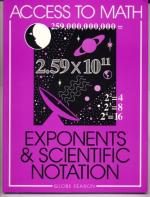|
This section contains 237 words (approx. 1 page at 300 words per page) |
When it is necessary to write very large or very small numbers, scientists and mathematicians use a method of notation that combines the significant digits of the number multiplied by ten with appropriate exponents that are integers. This is called scientific notation. When using this method, the numbers are often said to be multiplied by a power of ten. Positive powers of ten each add a zero to a number to the left of the decimal point, negative powers add a zero to the right of a decimal point. To illustrate, although these would not normally be used because they can be written and read more easily the usual way, in scientific notation, 1 would be written as 1 x 100, because 100=1. The number 10 would be written as 1 x 101, and 100 as 1 x 102. Working with numbers smaller than 1, 0.1 would be 1 x 10-1 in scientific notation, 0.01=1 x 10-2 and so on.
This method is a kind of shorthand that not only requires less writing, but also makes numbers more clear to the reader. With standard numeric notation, for example, one might have to count zeros to interpret a number like 0.00000000452, which, in scientific notation, takes fewer symbols to write and is easier, at a glance, to interpret: 4.52 x 10-9. This makes scientific notation very useful in working with the kinds of numbers often found especially in sciences where very large or small sizes and time frames are encountered.
|
This section contains 237 words (approx. 1 page at 300 words per page) |


